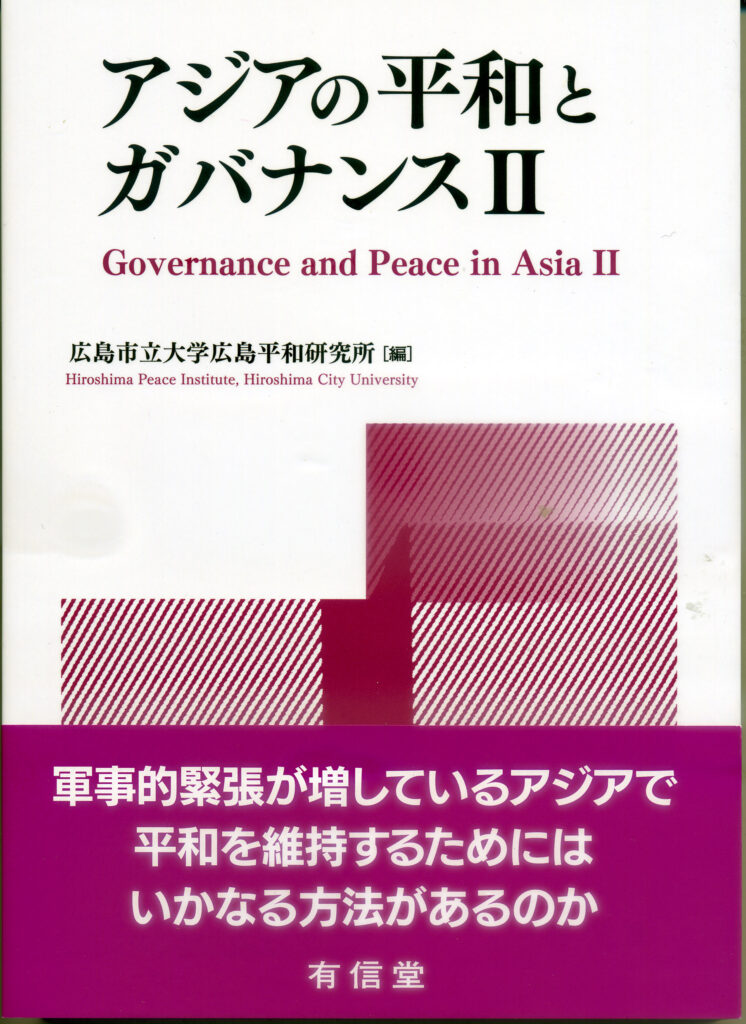
広島市立大学 広島平和研究所/編(有信堂、2025年3月)
ISBN978-4-8420-5590-9
A5判・296頁
定価:3,000円+税
本の概要
本書の前編である『アジアの平和とガバナンス』で問題視した東アジアの危機は、残念ながら収束に向かっておらず、ロシアのウクライナ侵攻に代表されるグローバル危機も深刻である。その上、主要国の政治が内向きになる中で、東アジアの危機を脱するために国家間の協力は可能なのだろうか。ロシアでもイスラエルでも一部の政治家が核兵器による恫喝を行う中で、核なき平和の実践は達成できるのだろうか。国際社会および東アジアの現況に対するこのような問題関心に基づき、広島平和研究所では、2025年3月に『アジアの平和とガバナンスII』(有信堂高文社)を刊行することとなった。本書の目的は、アジアの国際情勢と核開発が進むアジア各国の国家ガバナンスを踏まえた上で、国家間協力を制度化するリージョナル・ガバナンスの進展について、前書(『アジアの平和とガバナンス』)刊行以降の3年間の経緯を中心に分析することにある。
本書は序章で提起されたアジアのガバナンスと国際平和で提起された問題意識を踏まえ、全5部構成からなる。第1部「グローバル・ガバナンスの危機と東アジアの危機」では、東アジア国際関係の危機の構造と、ウクライナ戦争下で揺れる国連の役割を論じた。第2部「核開発国のガバナンス」では、アジアの核保有国および核開発の動きのある国の核開発の経緯や核戦略、および各国の自由化と民主化動向を中心としたガバナンス動向を検討した。第3部「人間の安全保障」では、アジアにおける人間の安全保障を概観したうえで、人権、難民、開発と環境について掘り下げた分析を行った。第4部「アジアのリージョナル・ガバナンス」では、制度化がまばらなアジアの特徴を踏まえ、平和創造に向けたアジアの国際組織化の近年の動向と現状を明らかにした。第5部「アジアの中の日本」では、主に日本の安全保障に焦点をあてた分析を行った。
本書がアジアの危機と各国の現状を知るきっかけとなり、同時にアジアで国際平和を促進する手立てを考察する一助となることを期待する。なお、本書は、広島平和研究所が編集した『アジアの平和と核――国際関係の中の核開発とガバナンス』(共同通信社、2019年2月)、『アジアの平和とガバナンス』(有信堂高文社、2022年3月)の続編である。本書を通じてアジアの現状を把握するのみならず、両書を合わせて参照していただき、アジアの平和をめぐる一連の歴史的経緯への理解を深めていただきたい。
目次・執筆者
はしがき (広島平和研究所 大芝 亮)
序章 アジアのガバナンスと国際平和 (広島市立大学 吉川 元)
[第1部 グローバル・ガバナンスの危機と東アジアの危機]
第1章 バイデン政権の東アジア太平洋政策——その成果と展望 (立教大学 佐々木 卓也)
第2章 中国の東アジア政策 (広島平和研究所 徐 顕芬)
第3章 韓国の東アジア政策 (神戸大学 木村 幹)
第4章 台湾の将来と東アジア情勢 (東京大学 川島 真)
第5章 グローバル危機と国連の役割 (広島平和研究所 佐藤 哲夫)
[第2部 核開発国のガバナンス]
第6章 中国のガバナンスと核戦略 (大東文化大学 鈴木 隆、防衛研究所 山口 信治)
第7章 北朝鮮の核開発とガバナンス (広島平和研究所 孫 賢鎮)
第8章 インドの核とガバナンス (中京大学 溜 和敏)
第9章 パキスタンの核開発とガバナンス (東京福祉大学 近藤 高史)
第10章 イランの核開発とガバナンス (同志社大学 中西 久枝)
[第3部 人間の安全保障]
第11章 アジアにおける人間の安全保障 (広島平和研究所 沖村 理史)
第12章 アジアにおける難民 (早稲田大学 山田 満)
第13章 アジアの人権——中国の動向を中心に (神戸大学 坂元 茂樹)
第14章 アジアにおける環境と開発 (広島平和研究所 沖村 理史)
[第4部 アジアのリージョナル・ガバナンス]
第15章 インド太平洋のリージョナル・ガバナンス (東海大学 西田 竜也)
第16章 ASEANのリージョナル・ガバナンス (名古屋大学 井原 伸浩)
第17章 上海協力機構とユーラシアの新地域主義 (広島平和研究所 加藤 美保子)
第18章 東アジア地域形成の経緯と現状 (早稲田大学 李 鍾元)
第19章 アジアの非核地帯構想と非核規範 (広島平和研究所 梅原 季哉)
[第5部 アジアの中の日本]
第20章 日本の安全保障 (東京大学 石田 淳)
第21章 日本の安全保障政策と憲法 (広島平和研究所 河上 暁弘)
第22章 日本の安全保障政策とアメリカの核 (共同通信社 太田 昌克)
あとがき
人名索引
事項索引
略語表
Governance and Peace in Asia II [Ajia no Heiwa to Gabanansu II]
Edited by the Hiroshima Peace Institute, Hiroshima City University
Published in March 2025 by Yushindo Kobun-sha
ISBN978-4-8420-5583-1
Price: 3,000 yen+tax
Book Description
Unfortunately, the crisis in Asia, which was highlighted in the prequel of this book, Governance and Peace in Asia [Ajia no Heiwa to Gabanansu], is showing no signs of being resolved, and the global crisis, represented by Russia’s invasion of Ukraine, is also serious. Moreover, as the politics of major countries turn inward, is cooperation between countries possible to overcome the crisis in Asia? With some politicians in both Russia and Israel threatening to use nuclear weapons, is it possible to achieve a nuclear-free peace? Based on these concerns about the current situation in the international community and Asia, the Hiroshima Peace Institute has published Governance and Peace in Asia II [Ajia no Heiwa to Gabanansu II] (Yushindo Kobun-sha) in March 2025. The purpose of this book is to analyze the progress of regional governance, which supports the institutionalization of interstate cooperation, over the three years since the publication of our previous book, Governance and Peace in Asia, in light of the international situation in Asia and the national governance of Asian countries developing nuclear weapons.
This book is divided into five parts based on the issues raised in its Introduction, “Asian Governance and International Peace.” Part 1, “The Crisis in Global Governance and the Crisis in East Asia,” discusses the structure of the crisis in international relations in East Asia and the unstable role of the United Nations amid the war in Ukraine. Part 2, “Governance of Nuclear-Developing Countries,” examines the history of nuclear development and nuclear strategies of Asian nuclear powers and countries moving toward nuclear development as well as governance trends centered on liberalization and democratization trends in each country. Part 3, “Human Security,” provides an overview of human security in Asia and then provides an in-depth analysis of human rights, refugees, development, and the environment. Part 4, “Regional Governance in Asia,” examines the history and current status of organizing of Asian countries toward peace-making, taking into account the characteristics of Asia with a low level of institutionalization of interstate cooperation. Part 5, “Japan in Asia,” focuses primarily on Japan’s security.
It is our hope that this book will serve as an opportunity to learn about the crisis in Asia and the current situation in each country, and at the same time, it will help you consider ways to promote international peace in Asia. This book is a sequel to Peace, Nuclear Weapons and Governance Issues in Asia [Ajia no Heiwa to Kaku] (Kyodo News, February 2019) and Governance and Peace in Asia [Ajia no Heiwa to Gabanansu] (Yushindo Kobun-sha, March 2022), both edited by the Hiroshima Peace Institute. We hope that readers will not only use this book to grasp the current situation in Asia but also refer to these books together to deepen their understanding of the historical process surrounding peace in Asia.
Research Project
https://www.peace.hiroshima-cu.ac.jp/archive/a-comprehensive-study-of-peace-and-governance-in-asia-2/
